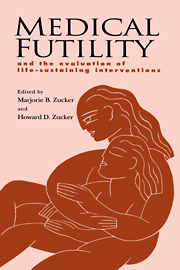Book contents
- Frontmatter
- Contents
- Preface
- Foreword
- Contributors
- 1 Medical futility: a useful concept?
- 2 Death with dignity?
- 3 Physicians and medical futility: experience in the critical care setting
- 4 Physicians and medical futility: experience in the setting of general medical care
- 5 Futility issues in pediatrics
- 6 Medical futility: a nursing home perspective
- 7 Alternative medicine and medical futility
- 8 How culture and religion affect attitudes toward medical futility
- 9 When religious beliefs and medical judgments conflict: civic polity and the social good
- 10 Conflict resolution: experience of consultation-liaison psychiatrists
- 11 Ethics committees and end-of-life decision making
- 12 The economics of futile interventions
- 13 Medical futility: a legal perspective
- 14 Professional and public community projects for developing medical futility guidelines
- 15 Community futility policies: the illusion of consensus?
- 16 Not quite the last word: scenarios and solutions
- Index of cited authors, cases, and statutes
- Subject index
3 - Physicians and medical futility: experience in the critical care setting
Published online by Cambridge University Press: 11 September 2009
- Frontmatter
- Contents
- Preface
- Foreword
- Contributors
- 1 Medical futility: a useful concept?
- 2 Death with dignity?
- 3 Physicians and medical futility: experience in the critical care setting
- 4 Physicians and medical futility: experience in the setting of general medical care
- 5 Futility issues in pediatrics
- 6 Medical futility: a nursing home perspective
- 7 Alternative medicine and medical futility
- 8 How culture and religion affect attitudes toward medical futility
- 9 When religious beliefs and medical judgments conflict: civic polity and the social good
- 10 Conflict resolution: experience of consultation-liaison psychiatrists
- 11 Ethics committees and end-of-life decision making
- 12 The economics of futile interventions
- 13 Medical futility: a legal perspective
- 14 Professional and public community projects for developing medical futility guidelines
- 15 Community futility policies: the illusion of consensus?
- 16 Not quite the last word: scenarios and solutions
- Index of cited authors, cases, and statutes
- Subject index
Summary
Intensive care units were created to facilitate and enhance the delivery of care to the most extremely ill patients. Underlying this concept was the assumption that grouping critically ill patients in one area staffed by physicians and nurses trained in the care of such patients would improve the delivery of care. This approach has been effective. Despite the high level of illness seen in the intensive care unit (ICU), hospital mortality rates for ICU patients range from 15% to 20%.
Paradoxically, the advances that have allowed a high survival rate have also created an increase in the number of individuals who survive in a state of chronic persistent illness. Many of these patients proceed to a slow death at the expense of both human suffering and dollars spent. As a consequence, the process of dying has been scrutinized as closely as other more traditional aspects of health care delivery. How we die in the ICU has become an issue.
The public has become more sophisticated about the strengths and weaknesses of critical care and is asking more frequently that physicians not administer care that fails to confer benefit to the patient. Similarly, some physicians have become more sophisticated about the limitations of medical care and about the suffering that can result from invasive, yet unfruitful, therapy and are now less willing to administer care that they consider of no benefit, even in the rare circumstances when they are asked to do so.
- Type
- Chapter
- Information
- Medical FutilityAnd the Evaluation of Life-Sustaining Interventions, pp. 24 - 35Publisher: Cambridge University PressPrint publication year: 1997
- 1
- Cited by

